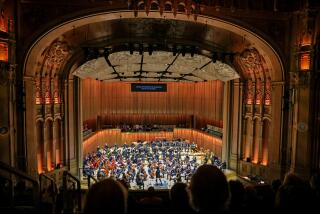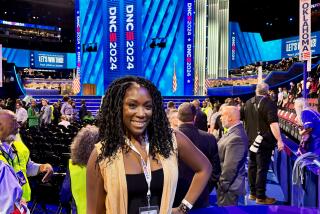Convention Organizers Refuse to Say the S-Word
- Share via
SAN DIEGO — There’s a word you won’t hear from the lips of the people organizing the Republican National Convention, set to begin next week.
Yes, the glass and concrete and chrome convention center in San Diego can accommodate only a third of the number of people who attended the GOP convention in Houston in 1992.
And, yes, the square footage of the main showroom is far less than that of the domed stadiums and cavernous halls that have hosted conventions of both parties for a long time.
But the San Diego Convention Center is not s-m-a-l-l. It’s intimate.
“We’re going to have a very intimate and exciting convention,” promised Thomas Schwinn, the convention podium designer.
“We’re going to make it a very intimate national convention,” said Joseph Martinez, chief architect for the convention.
*
“This is going to be a much more intimate convention, more much user-friendly than other venues of the past,” said Bill Evans, the San Diego hotelier who serves as president of the convention center board of directors.
Still unknown is whether the television networks will buy into the local spin that the hall is not pint-sized but intimate.
“Well, that would be one way to put it,” said Lane Venardos, CBS News vice president in charge of news and special events. “From our standpoint, it’s the smallest hall that [has hosted] a convention since the advent of television.”
Jeff Gralnick, chief of political coverage for ABC, told a Hollywood gathering of TV critics that the convention center is “the worst hall I have seen in my life.”
The attitude of the networks--and other members of the media--toward the convention center is no trifling matter.
*
Republicans don’t want carping about size and sight lines to interfere with their political message to voters. San Diego boosters are worried that criticism of the convention center could short-circuit the good publicity the city hopes to reap from the convention.
“The networks execs’ complaints, while hardly astonishing, are something akin to the guests at a wedding squawking about the size of the church,” an editorial in the San Diego Union-Tribune said.
Of course, the San Diego Convention Center is no less big now than it was when San Diego bested other cities with bigger accommodations in the bidding war to host the convention.
“The Republicans knew long ago that San Diego’s character is very intimate and they played to that,” Martinez said.
“The size of the room is going to make it seem like a gathering of people who know each other and have come here for a common purpose,” Schwinn said.
Beyond the specifications of the convention center, there are also questions about what the television networks will choose to broadcast from the four-day affair. The party is promising a new type of event, what Paul Manafort, convention organizer for presumptive nominee Bob Dole, calls “political television.”
After listening to focus groups that criticized long, boring speeches by tired political regulars, the GOP has decided on short speeches, some from ordinary people, some delivered by video clips.
“It appears to me that they have made a quantum leap forward,” said Tom Hannon, director of CNN’s political unit.
Needing a big surge in voter support from their convention, Republicans studied network schedules in such minute detail that they know when there could be commercials and how to put filler into the news breaks.
“It’s almost as if they are producing their own TV show,” Hannon said, noting that the Republicans are making sure their message is repeated in short enough segments for a viewer clicking through the channels.
Gralnick said last week that the networks will see how the events inside and outside the hall affect the electoral process before deciding what to cover.
“We are not there to cover their show,” he said. “We are there to cover the news that happens at the convention hall.”
The three big networks have decided to scale back their coverage to late prime time--an hour to two hours per night, in most cases. CNN is expected to focus on the convention news throughout the day, giving the event full attention from 8 p.m. to at least 11 p.m. EST.
Criticism of the convention center by Gralnick and others is particularly galling to local ears. The waterfront center, built in 1989 after much political wrangling, is considered a municipal pride and joy, an architectural marvel and a huge economic success.
“The convention will have the feel of an old-time political convention, of democracy being done on a human scale,” said Mayor Susan Golding. “These giant places are not what democracy is about. This will be a town hall convention.”
Through the redesign work by Martinez, the seating capacity of the 254,000-square-foot hall will be 20,000-plus--still far below the 60,000-plus who flocked to the Astrodome in 1992.
Even with the redesign, about 10% of the attendees will not be able to see the podium. Their views will be blocked by pillars, photo stands, and the massive skyboxes for the television networks.
Not to worry. Fifty-five 70-inch television monitors will dot the hall, and two 6-foot-by-6-foot “video walls” will flank the podium.
Balloons may be a different matter. Nothing in the Constitution requires a cascade of red-white-and-blue balloons but they have become a fixture at conventions.
Dole, in a quickie inspection of the convention center this spring, worried that the 27 1/2-foot high ceiling would not be conducive to a balloon drop. The ceiling at the United Center in Chicago, where the Democrats will hold their convention, is 136 feet.
William Greener III, the Republican convention manager, declined to say whether there will a balloon drop come Aug. 16, the final day of the convention.
Among the San Diego organizers and GOP officials, it is an article of faith that, balloons or no balloons, the intimate convention will be the wave of the future.
“After the San Diego convention, the day of holding these conventions in 120-degree heat in the Northeast and South in these big empty barns will be over,” said Evans, president of the center’s board of directors. “San Diego is changing all the ground rules for conventions.”
Perry reported from San Diego, Randolph from New York.
More to Read
Get the L.A. Times Politics newsletter
Deeply reported insights into legislation, politics and policy from Sacramento, Washington and beyond. In your inbox twice per week.
You may occasionally receive promotional content from the Los Angeles Times.










